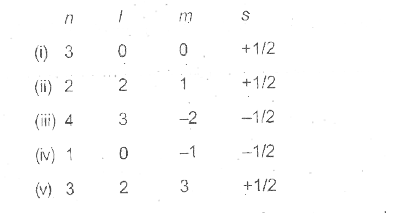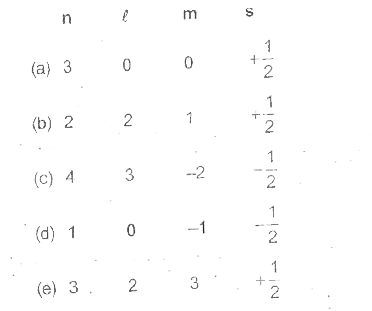Which of the following set of quantum number is possible ?
n=4 , l=2, m=-2 ,s=-2
n=4,l=4,m=0,s=12
n=4,l=3,m=−3,s=12
n=4,l=0,m=0,s=0
The correct Answer is:C
To determine which set of quantum numbers is possible, we need to understand the rules governing quantum numbers. Quantum numbers describe the properties of atomic orbitals and the electrons in them.
1. Understanding Quantum Numbers:
- There are four quantum numbers:
- Principal quantum number (n)
- Azimuthal quantum number (l)
- Magnetic quantum number (m)
- Spin quantum number (s)
2. Principal Quantum Number (n):
- The principal quantum number (n) can take any positive integer value (1, 2, 3, ...).
- In this case, we have n = 4.
3. Azimuthal Quantum Number (l):
- The azimuthal quantum number (l) can take values from 0 to (n-1).
- For n = 4, l can be 0, 1, 2, or 3.
4. Magnetic Quantum Number (m):
- The magnetic quantum number (m) can take values from -l to +l.
- For each value of l, m can take (2l + 1) values.
- For l = 0, m = 0; for l = 1, m = -1, 0, +1; for l = 2, m = -2, -1, 0, +1, +2; for l = 3, m = -3, -2, -1, 0, +1, +2, +3.
5. Spin Quantum Number (s):
- The spin quantum number (s) can only take two values: +1/2 or -1/2.
6. Evaluating the Options:
- Option 1: n = 4, l = 2, m = -2, s = ±2
- Here, s = ±2 is incorrect. The spin quantum number must be ±1/2.
- Option 2: n = 4, l = 3, m = 3, s = ±1/2
- This is correct. n = 4, l = 3 (valid), m = 3 (valid), s = ±1/2 (valid).
- Option 3: n = 4, l = 0, m = 0, s = 0
- s = 0 is incorrect. The spin quantum number must be ±1/2.
- Option 4: n = 4, l = 3, m = -3, s = ±1/2
- This is also correct. n = 4, l = 3 (valid), m = -3 (valid), s = ±1/2 (valid).
7. Conclusion:
- The possible sets of quantum numbers are:
- Option 2: n = 4, l = 3, m = 3, s = ±1/2
- Option 4: n = 4, l = 3, m = -3, s = ±1/2
- There are four quantum numbers:
- Principal quantum number (n)
- Azimuthal quantum number (l)
- Magnetic quantum number (m)
- Spin quantum number (s)
- The principal quantum number (n) can take any positive integer value (1, 2, 3, ...).
- In this case, we have n = 4.
- The azimuthal quantum number (l) can take values from 0 to (n-1).
- For n = 4, l can be 0, 1, 2, or 3.
- The magnetic quantum number (m) can take values from -l to +l.
- For each value of l, m can take (2l + 1) values.
- For l = 0, m = 0; for l = 1, m = -1, 0, +1; for l = 2, m = -2, -1, 0, +1, +2; for l = 3, m = -3, -2, -1, 0, +1, +2, +3.
- The spin quantum number (s) can only take two values: +1/2 or -1/2.
- Option 1: n = 4, l = 2, m = -2, s = ±2
- Here, s = ±2 is incorrect. The spin quantum number must be ±1/2.
- Option 2: n = 4, l = 3, m = 3, s = ±1/2
- This is correct. n = 4, l = 3 (valid), m = 3 (valid), s = ±1/2 (valid).
- Option 3: n = 4, l = 0, m = 0, s = 0
- s = 0 is incorrect. The spin quantum number must be ±1/2.
- Option 4: n = 4, l = 3, m = -3, s = ±1/2
- This is also correct. n = 4, l = 3 (valid), m = -3 (valid), s = ±1/2 (valid).
- The possible sets of quantum numbers are:
- Option 2: n = 4, l = 3, m = 3, s = ±1/2
- Option 4: n = 4, l = 3, m = -3, s = ±1/2
Topper's Solved these Questions
- STRUCTURE OF ATOMBOOK - AAKASH INSTITUTECHAPTER - STRUCTURE OF ATOMEXERCISE - ASSIGNMENT (SECTION -B) Objective type questions
34 Videos
- STRUCTURE OF ATOMBOOK - AAKASH INSTITUTECHAPTER - STRUCTURE OF ATOMEXERCISE - ASSIGNMENT (SECTION -C) Previous Years Questions
47 Videos
- STRUCTURE OF ATOMBOOK - AAKASH INSTITUTECHAPTER - STRUCTURE OF ATOMEXERCISE - EXERCISE
40 Videos
- STATES OF MATTERBOOK - AAKASH INSTITUTECHAPTER - STATES OF MATTEREXERCISE - ASSIGNMENT (SECTION-D)
15 Videos
- STRUCTURE OF ATOM BOOK - AAKASH INSTITUTECHAPTER - STRUCTURE OF ATOM EXERCISE - ASSIGNMENT ( SECTION -J) Aakash Challengers Questions
12 Videos
Similar Questions
Consider the following sets of quantum number

Which of the following sets of quantum number is not possible ?
View SolutionConsider the following sets of quantum numbers.
(i) nlms300+1/2
(ii) nlms221+1/2
(iii) nlms43−2−1/2
(iv) nlms10−1−1/2
(v) nlms323+1/2
Which of the following sets of quantum number is not possible ?
View Solution
Knowledge Check
Which of the following set of quantum numbers is not possible ?
An=3,l=0,m=0Bn=3,l=1,m=−1Cn=2,l=0,m=−1Dn=2,l=1,m=0Which of the following sets of quantum number is not possible
An=4,l=1,m=0,s=+1/2Bn=4,l=3,m=−3,s=−1/2Cn=4,l=−1,m=+2,s=1/2Dn=4,l=1,m=0,s=−1/2Which of the following sets of quantum number is not possible
An=3,1=+2,m1=0,ms=+1/2Bn=3,1=0,m1=0,ms=−1/2Cn=3,1=0,m1=−1,ms=+1/2Dn=3,1=1,m1=0,ms=+1/2
Which of the following sets of quantum numbers is not possible?
View SolutionWhich of the following sets of quantum numbers is not possible?
View SolutionConsider the following sets of quantum number

Which of the following sets of quantum number is not possible?
View SolutionConsider the following sets of quantum number

Which of the following sets of quantum number is not possible?
View SolutionConsider the following sets of quantum numbers

which of the following sets of quantum number is not possible ?
View Solution
